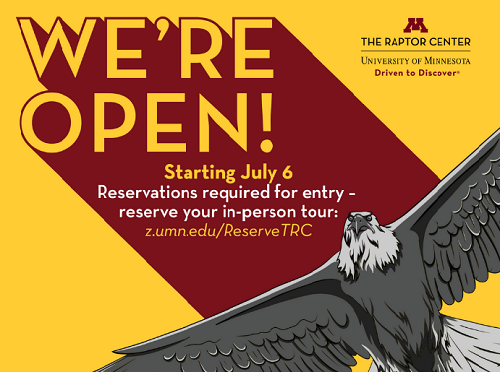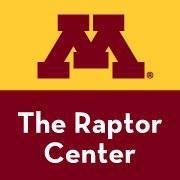Cool Jobs: Kelsey Griffin, Interpretive Naturalist, The Raptor Center
 Monday, July 12, 2021 at 4:20PM |
Monday, July 12, 2021 at 4:20PM |  Becky Fillinger |
Becky Fillinger | Article by Becky Fillinger
 Kelsey Griffin
Kelsey Griffin
Ever wonder what it would be like to work with raptors – designing programs, leading field trips and even reading along with these elegant birds? Meet Kelsey Griffin, Interpretative Naturalist at the Raptor Center. We talked to her about how she became interested in raptors and how that parlayed itself into an amazing career.
Q: Tell us how you became interested in raptors.
A: I've always loved animals and the natural sciences like biology and geology. When I was a kid, I wanted to be a veterinarian or a marine biologist, though as I got older, I thought I might go into human medicine instead. Once I got to the U of MN College of Biological Sciences, it became really clear that my interests really were in the fields of biology involving evolution, ecology, and behavior. I loved learning about organisms and how they functioned, and more importantly, why they might function that way and the many thousands of years of evolutionary history that went into it. There's intense scientific research that goes into trying to figure those things out, but there's also a story - and as anyone who has met me will tell you, I love sharing stories.
This was my jumping off point into raptors. I visited The Raptor Center once, right after my freshman year of college, and was so intrigued that I knew I wanted to volunteer with the education team. I had always liked birds, sure, but I liked a lot of different creatures. The more time I spent teaching people about these birds, though, the more fascinated I was with them and all of the tiny intricate details of biology that allow them to function in the ecosystem. Being able to share some of that with people and watching them also get excited about birds and the environment is really exhilarating and just makes me want to learn and share even more.
Q: You’re an interpretive naturalist at the Raptor Center. Do you have broad discretion in putting together programs? Any new programs that you hope to offer?
A: I work as part of a team of naturalists, educators, and veterinarians who all put their heads together to figure out what information we are getting from our wild raptor patients and how we can best share that with the public. We want to give people the best, most updated picture of what is happening in our shared environment, so we are always thinking about how best to do that. Moving a lot of that online over the last year has been great for developing new programs, and right now I know I am thinking a lot about how to take some of the best parts of online learning and bringing that back to our in-person programs. Here’s a short video of our virtual field trips! Check out our Programs and Events tab on our web site for a list of available programs for all ages.
Q: Do the Center’s raptors take field trips to visit schools or other groups?
A: Visiting schools, community centers, and other places is one of the main jobs for our resident ambassador birds! During most years we do around 1200 programs, split roughly 50:50 between on-site visitors and off-site programs. We'll build back up towards that as safety allows, and it will be very interesting to see what interest remains in our online teaching over the next few years.

Q: Is the Center open now for touring?
A: Yes, we reopened for public tours on July 6th! Currently these tours will be at a limited capacity and require online registration at z.umn.edu/ReserveTRC. Just like the many of us, the birds also need to get used to seeing larger numbers of people in their living spaces again, so keep an eye out for more updates on our tours and other in-person programs.
Q: This might be a Sophie’s Choice question - do you have a favorite Raptor species?
A: This is always such a tough question! Every raptor species has so many cool adaptations that it makes it so hard to pick, but I do have a few that I usually tell people. For Minnesota raptors and birds I have actually worked with, I have to say American Kestrels for their incredible hovering flight, gutsy defense of their nests and youngsters, and flashy feather patterns (well, for a raptor, at least). They're also really rewarding to work with for training!
Other favorites are more international. One is the bearded vulture aka lammergeier, which is a giant fluffy vulture that lives in the mountains of Europe and Asia and mainly eats bones that have already been picked clean by other scavengers. It's hard to think of something cooler than a bird that dissolves whole bones in its stomach, right? Another favorite is the secretary bird, a very tall and flashy raptor that lives in the open grasslands of sub-Saharan Africa. They use their powerful long legs to stomp on snakes with incredible force and speed, a pretty unique use of those classic raptor talons.
 Q: How may we follow your news?
Q: How may we follow your news?
A: Folks can check out The Raptor Center's website at theraptorcenter.org, along with the Facebook page and on Instagram @theraptorcenter. Now is a great time to follow us and sign up for our newsletter to stay updated on our reopening plans, plus with the busy season starting in the clinic there are sure to be lots of interesting pictures and stories posted.
